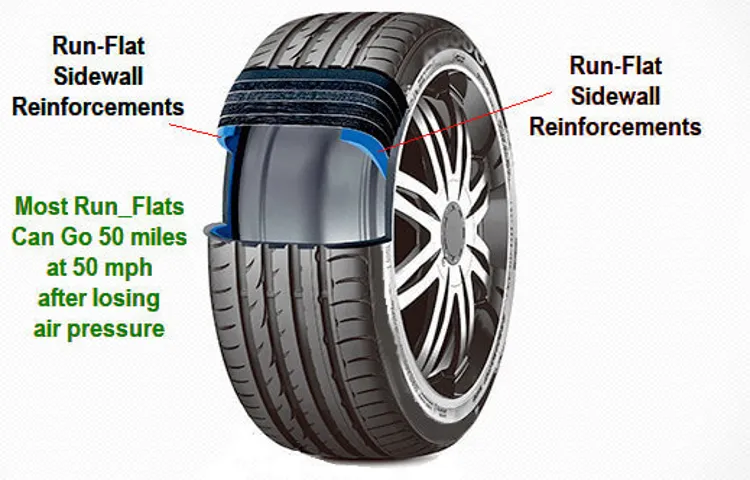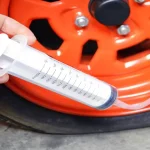Do you ever worry about experiencing a flat tire while driving? It can be a nerve-wracking and potentially dangerous situation, especially if you’re on a busy highway or in an isolated area. That’s where run-flat tires come in. These specialized tires are designed to keep you driving even after a puncture, allowing you to make it to a repair shop or safety.
But how do you know if you have run-flat tires on your vehicle? In this blog, we’ll discuss how to easily identify run-flat tires and what makes them stand out from traditional tires.
Table of Contents
Visual Inspection
If you suspect that your tire may be run flat, the first and most important thing to do is to inspect it visually. Look for any obvious signs of damage, such as bulges, cracks, punctures, or cuts. Check the tire’s pressure and compare it to the recommended pressure listed in your owner’s manual.
If the tire is significantly underinflated, this may indicate that it has been run flat. Another visual clue is uneven wear across the surface of the tire. If you notice that the tread is worn more on one side than the other, this could be a sign that the tire has been run flat or is misaligned.
Don’t forget to also check the spare tire, as it can also be affected by a run flat tire situation. Remember that catching tire damage early can help to prevent dangerous blowouts and prolong the life of your tires.
Check the sidewalls for special markings
When it comes to checking the condition of your tires, there are a few things you should always look for. One of the most important is the condition of the sidewalls. Not only can cracks or bulges be a sign of a potentially dangerous tire blowout, but certain markings on the sidewalls can also tell you a lot about the tire itself.
For example, the size and type of tire, as well as the load and speed ratings, are often listed on the sidewall. You may also find symbols indicating whether the tire is designed for use in wet conditions or if it is meant for off-road driving. So next time you’re giving your tires a once-over, be sure to check those sidewalls for any signs of wear and tear or special markings to help you get the most out of your tires and keep you safe on the road.

Look for reinforced sidewalls
When it comes to buying new tires for your vehicle, it’s essential to consider their sidewalls’ reinforcement. Reinforced sidewalls can drastically improve your tire’s performance and safety, making them more resistant to punctures, cuts, and impacts. The easiest way to determine if your tires have reinforced sidewalls is to perform a visual inspection.
Check for additional rubber sections or thickness in the area surrounding the tire’s bead. If you can see additional grooves or patterns, it means that the manufacturer has taken extra steps to strengthen the tire’s sidewalls. Keep in mind that tires with reinforced sidewalls can also offer better handling, particularly when driving off-road or on rough terrain.
So, the next time you find yourself shopping for new tires, make sure to look for those with reinforced sidewalls to ensure your safety on the road.
Inspect the tire for a support ring
When conducting a visual inspection of your tire, one important step is to check for a support ring. This ring is located on the inside of the tire, near the bead area. Its purpose is to provide additional support and stability to the tire, especially during high-speed driving or heavy loads.
To inspect for a support ring, you can use a flashlight and look carefully along the bead area. If the tire has a support ring, it will appear as a raised ridge around the inside circumference of the tire. If you are unsure or cannot locate the support ring, consult your tire manufacturer’s manual, or take the tire to a professional for an inspection.
Remember, checking for a support ring is just one step in maintaining the safety and integrity of your tire. Regular inspections, proper inflation, and timely repairs or replacements are equally important to ensure your tire performs at its best.
The penny test
If you want to know if your tire is run flat, you can try the penny test. Simply take a penny and insert it into the grooves of your tire with Lincoln’s head facing down. If you can see the top of his head, that means your tire is worn down and needs to be replaced.
This is a simple and easy way to check the wear on your tires and can help prevent dangerous situations on the road. It’s important to keep an eye on your tire tread and replace them as needed to ensure your safety while driving. By performing the penny test regularly, you can keep your tires in good condition and avoid potential accidents on the road.
Place the penny in the tread groove
If you’re concerned about the traction of your tires, a quick and easy way to check is with the penny test. Just grab a penny out of your pocket and place it in one of the tread grooves on your tire. If you can see Lincoln’s head, it’s time for new tires.
This might seem like a small thing, but the quality of your tires can make a big difference in your safety on the road. As the tread wears down, it becomes harder for your tires to grip the road, especially in wet or icy conditions. And while it might be tempting to put off buying new tires to save money, it’s not worth the risk.
So don’t forget to give your tires the penny test and stay safe on the road!
Observe the position of Lincoln’s head
When it comes to examining a coin, specifically a penny, the “penny test” can be quite informative. One important aspect to observe is the position of President Lincoln’s head. On a genuine penny, his head should be centered and facing forward.
If the head appears off-center or tilted, it could be a sign that the penny is counterfeit. Additionally, the texture and overall appearance of the coin can provide further clues. A genuine penny should have a smooth, shiny surface with clear and defined text and images.
Any signs of wear or blurry text could also indicate a counterfeit. By using the penny test and paying close attention to the position of Lincoln’s head, collectors and enthusiasts can ensure they are adding authentic coins to their collections.
Repeat the test in different grooves
If you’re wondering whether your tires have enough tread, you can perform the penny test. This test involves placing a penny with Lincoln’s head facing down into the grooves of your tire. If you can see all of Lincoln’s head, it’s time to replace your tires.
However, it’s important to note that you should repeat the test in different grooves to ensure accuracy. Tires can wear unevenly, so just because one area passes the penny test doesn’t mean the rest of the tire is safe. By checking multiple grooves, you can get a better overall picture of your tire’s condition.
Remember, properly inflated and well-maintained tires are essential for safety on the road.
The Tire Pressure Monitoring System
Have you ever wondered how to know if a tire is run flat? Well, the answer lies within the Tire Pressure Monitoring System (TPMS) of your vehicle. The TPMS is a smart system that alerts drivers about low tire pressure or a flat tire by illuminating a warning light on the dashboard. It measures the air pressure inside the tires and sends the data back to the car’s computer.
If there is a sudden loss of air pressure, the TPMS will send an alert to the car’s computer and turn on the warning light. This provides drivers with the opportunity to take immediate action and prevent further damage to their tires. The TPMS has become an essential feature in modern cars as it helps ensure safety on the roads.
So, next time you see the warning light for a low tire pressure, don’t ignore it, as it might indicate that your tire is run flat.
Check the vehicle’s manual or specification
When it comes to maintaining proper tire pressure, most modern vehicles come equipped with a Tire Pressure Monitoring System (TPMS). This handy feature uses sensors to monitor the pressure of each tire and alerts the driver if any are low or overinflated. However, it’s always a good idea to double-check the recommended tire pressure for your specific vehicle.
You can find this information either in the owner’s manual or on the specification placard located on the driver’s side door frame. It’s essential to ensure your tires are inflated to the recommended pressure to prevent uneven wear, poor handling, and decreased fuel efficiency. So take a few minutes to check the manual or the specified tire pressure and adjust your tires’ air accordingly to ensure a safe, efficient, and comfortable ride.
Monitor the TPMS warning light
Have you ever seen a warning light on your dashboard and wondered what it meant? If you haven’t, there’s a good chance that you will encounter the Tire Pressure Monitoring System (TPMS) warning light at some point. This system is designed to alert drivers when their tire pressure is too low, which can lead to unsafe driving conditions and potential tire failure. It’s important to monitor the TPMS warning light regularly, as low tire pressure can cause decreased fuel efficiency and increased tire wear.
Additionally, it can affect your car’s handling and braking, which can be dangerous in emergency situations. If you see the TPMS warning light come on, take your car to a mechanic as soon as possible to ensure that your tires are properly inflated. By being proactive about tire pressure, you can ensure that your car is safe to drive and that your tires last as long as possible.
Conclusion
In summary, if you’re driving and suddenly hear a thud, feel a wobble, or notice a difference in handling, it’s possible you have a flat tire. But if you’re driving on a run-flat tire, you may not notice anything at all except a dashboard warning light. So, the real trick to knowing if you have a run-flat tire is to keep an eye on your dashboard and be prepared for anything, except for changing a tire on the side of the road.
“
FAQs
What is a run-flat tire and how does it work?
A run-flat tire is designed with reinforced sidewalls that allow you to continue driving on them even after a loss of air pressure. This helps you to reach a safe destination without the need to change the tire immediately.
Can I continue driving on a run-flat tire for an extended period?
While a run-flat tire can be driven for a certain distance with no air pressure, it is not recommended to continue driving on it for an extended period. It is important to replace the tire as soon as possible to avoid any potential safety risks.
How can I tell if my tire is a run-flat tire?
Run-flat tires are usually marked with an “RFT” on the sidewall. Additionally, you can check your vehicle’s owner’s manual or consult with a tire professional to confirm if your tires are run-flat.
What are the benefits of using run-flat tires?
Run-flat tires offer several benefits, including improved safety in case of a tire blowout or puncture, reduced need for a spare tire, and enhanced stability and handling.
How much do run-flat tires cost compared to regular tires?
Run-flat tires are generally more expensive than regular tires due to their advanced construction and added safety features. However, the cost may vary depending on the brand, size, and other factors.
Can run-flat tires be repaired if they get punctured?
Run-flat tires can be repaired in certain circumstances, depending on the location and extent of the damage. However, it is always better to replace a damaged run-flat tire to ensure maximum safety on the road.
Do all cars come with run-flat tires?
No, not all cars come with run-flat tires. Run-flat tires are typically used in performance or luxury vehicles, or as an optional upgrade on some models. It is important to check your vehicle specifications to determine if your car requires or supports run-flat tires.



